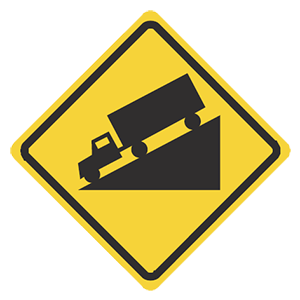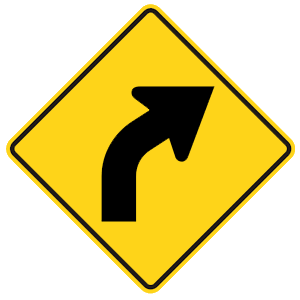2025 Delaware Permit Test 23
The following questions are from real DMV written tests. These are some of the actual permit questions you will face in Delaware. Each permit practice test question has three answer choices. Select one answer for each question and select "grade this section." You can find this button at the bottom of the drivers license quiz. For a complete list of questions and answers for Delaware please visit https://cheat-sheets.dmv-written-test.com/en/delaware/car.
Number of Tests
Number of Question
Passing Score
1. This sign means:

Explanation
This sign warns of a dangerous downgrade or hill ahead. The hill may be very long or steep, or it may have sharp curves.
2. This sign is used to warn drivers about:

Explanation
Warning signs are usually yellow with black markings. They alert you to conditions that are immediately ahead. This sign is used to warn drivers about an upcoming curve to the right.
3. When driving in fog or mist, never put your headlights on the high beam setting because:
Explanation
In foggy or misty conditions, you should not use your headlights on their high beam setting because the light will be reflected back into your eyes.
4. Increase your following distance when driving behind a large vehicle:
Explanation
Drivers of trucks, buses, vans, and any vehicles pulling campers or trailers may not be able to see you if you are driving directly behind them. Increase your following distance when driving behind one of these vehicles. Additionally, large vehicles can block your view of the road, so increase your following distance to look around the sides of the vehicle and see the road ahead.
5. If you are being passed in a no passing zone, you should:
Explanation
Passing areas are based on how far ahead drivers can see. Allow the passing vehicle to re-enter the drive lane as easily as possible to help everyone avoid potential upcoming hazards.
6. You are preparing to exit the interstate. When should you start reducing your speed?
Explanation
When leaving an interstate, you should maintain your speed until you enter the deceleration lane, at which point you should reduce your speed to the exit ramp's posted advisory speed.
7. Which of these statements is true about driving and taking medications?
Explanation
Remember that all medications, prescription or over-the-counter, are potentially dangerous and could impair your driving. Over-the-counter medicines that you take for colds and allergies can make you drowsy and affect your driving ability. It is your responsibility to know how your medication affects your ability to drive.
8. Make room for cars that are entering the freeway by:
Explanation
